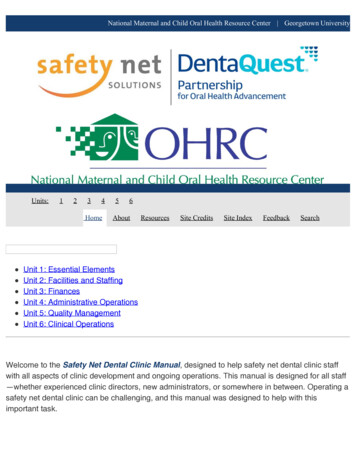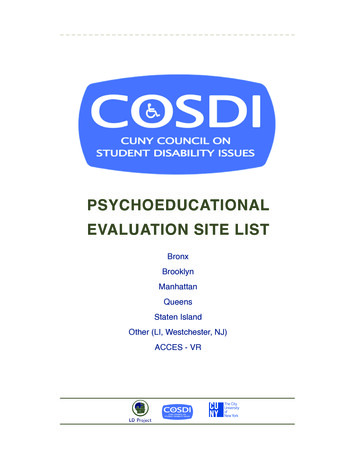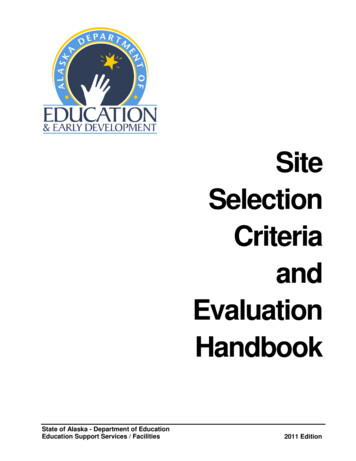
Transcription
SiteSelectionCriteriaandEvaluationHandbookState of Alaska - Department of EducationEducation Support Services / Facilities2011 Edition
CONTRIBUTORSSam Kito III, P.E.Facilities EngineerAlaska Department of Education and Early DevelopmentJuneau, AlaskaScott Thomas, P.E.Alaska Department of Transportation and Public FacilitiesAnchorage, AlaskaACKNOWLEDGEMENTSThanks to the Bond Reimbursement and Grant Review Committee members who reviewed thepublication in its draft form and to those at the Department of Transportation and Public Facilities,Division of Facility Procurement Policy Division who were responsible for the predecessor to thisdocument. Special thanks to Tim Mearig, AIA, Edwin Crittenden, FAIA and Michael Morgan, PMPwho shepherded earlier versions of this document through to completionThis publication may not be reproduced for sale by individuals or entities other than the:State of AlaskaDepartment of EducationJuneau, AlaskaThis publication was originally adapted from a November 1978 document published by the State ofAlaska Department of Transportation and Public Facilities, Division of Facility Procurement Policy,entitled Site Selection Criteria and Evaluation Guideline for Educational Facilities in Rural Alaska.State of Alaska - Department of EducationSite Selection Criteria and Evaluation Handbook - 2011 Edition
Table of ContentsSECTION . PageINTRODUCTION.2BASIC PROCEDURES .3Site Selection ElementsWeighting FactorsApplying Ranking CriteriaTabulating and Analyzing ResultsRANKING CRITERIA ELEMENTS .5THE EVALUATION REPORT . 24Introduction and Executive SummaryMaps and GraphicsEvaluation Matrix and NarrativesAPPENDICESAPPENDIX A .25Evaluation MatrixAPPENDIX B .28Sample Site Graphic AnalysisAPPENDIX C .29Suburban School LayoutState of Alaska - Department of EducationSite Selection Criteria and Evaluation Handbook - 2011 Edition1
IntroductionOverviewThe perfect school site can be envisioned as generally level with some topographic interest, havingcomplete utilities, stable, well drained soils, excellent road and pedestrian access, protection fromexcessive weather patterns, with ample space for school facilities, playground and sports fields. Thesite would be accessible to present and future populations and be free of any natural orenvironmental hazards. It would be removed from undesirable business, industry and traffic hazardsbut be convenient to important public facilities and recreational/outdoor learning areas. In mostcommunities, however, the perfect site is elusive and difficult to find.School siting is also a serious public policy decision. Land availability, land use, public sentimentand other community issues can have dramatic influence on site selection. In any site selectionprocess, local involvement and judgments regarding the relative significance of selection criteria areimportant.This Site Selection Criteria Handbook was developed with flexibility in mind, and can be used byschool districts to perform a site selection analysis for any school facility by carefully selecting theappropriate criteria and weighting factors. Districts can use this guide for analysis of siteopportunities for elementary schools, secondary schools, charter schools, alternative schools andspecial purpose facilities.Finally, site selection for school facilities has a direct and lasting impact on the resources of the Stateof Alaska. Both the economic resources and the natural resources of the state are affected by theconstruction and operation of public schools. Primarily in response to these factors, the staterecognizes the need for careful and thorough evaluation of school sites.AuthorityThe guidelines incorporated in this handbook have been developed to give assistance and directionto Alaska school districts and communities in determining the suitability of various building sites foreducational facilities planning. They are based upon AS 14.11.013 and 14.11.100, which providesfor department review of projects to ensure they are in the best interest of the state. This provision isfurther developed by regulation 4 AAC 31.025 which requires approval of educational facility sitesunder paragraph (a) and investigations by the appropriate local governing body for suitability inparagraph (d). This handbook establishes the basic considerations for an adequate site selectionprocess. Other products of similar detail may be used to fill the requirements laid out in statute andregulation.State of Alaska - Department of EducationSite Selection Criteria and Evaluation Handbook - 2011 Edition2
Basic ProceduresSite Selection ElementsThis handbook establishes a set of basic site selection elements and offers suggested evaluationcriteria for rating the elements. Although the document does incorporate an internal weightingfactor (it lists a few key ranking criteria elements which have high cost impacts in more than onesub-category) it does not prescribe the importance of most selection elements but rather, incorporatesa weighting system whereby a district or community can assign a range of importance to eachelement. It is recognized that information for all the elements cannot always be determined nor areall elements applicable to every site. However, detail and rigor in addressing the elements isimportant for an effective evaluation.The selection elements are grouped into three major categories as follows:1. Social and Land Use Factors2. Construction Cost Factorsa) Soils/Foundationsb) Utilitiesc) Other3. Operations and Maintenance Cost FactorsThe site selection elements form the basis for an evaluation matrix which is shown in Appendix Aand is available as a spreadsheet on the department’s website. The first step in the process is toreview the matrix elements for applicability to the project and sites being considered.Weighting Factors (WF)After identifying the site selection elements, the next step is to assign weighting factors to eachelement. Assignment of the weighting factors is the district/community’s opportunity to apply itsvalues to the evaluation process so that the final scores for each site reflect issues involved at thelocal level. This is often accomplished through community surveys, public meetings and otherforums for developing consensus among the parties affected by the school project. A suggestedmodel for the district/community weighting factors is shown below:Weighting Factors1 not very important2 somewhat important3 important4 very important5 essentialState of Alaska - Department of EducationEducation Support Services / Facilities2011 Edition
Basic ProceduresApplying Ranking CriteriaFollowing the assignment of the weighting factors, each selection element is evaluated according toestablished criteria and ranked on the simple five point scale from 0 to 4. The detailed rankingcriteria to be used, which differentiates as needed between rural and urban sites, is describedfollowing this section on Basic Procedures. The table below gives a suggested definition of eachranking score:Criteria Ranking Scores0 unacceptable (least desirable/least cost effective)1 poor2 fair3 good4 excellent (most desirable/most cost effective)Tabulating and Analyzing ResultsUsing the Site Evaluation Matrix (Appendix A) enter the criteria ranking scores for each element.Compute the total score for each site by multiplying each criteria score by the weighting factor andsum them. An example of a portion of the Site Evaluation Matrix is shown below:Maintenance and Operating Cost FactorsCriteriaSite DrainageFloodingSite ErosionSun OrientationProtection from ElementsProximity to Natural HazardsAlternative Energy SourcesAir Inversions/Katabatic WindsTOTALSWF Site34422432144323014S1 xWF1216124603861Site234313314S2 xWF9161226123868Site332312424S3 x SiteWF49n/a8n/a12n/a2n/a4n/a16n/a6n/a8n/a65S4 xWFn/an/an/an/an/an/an/an/an/aThe total scores for each site represent a detailed analysis; the highest score should indicate the mostdesirable site. If the district or community, based on factors not captured by the evaluation, desiresto choose a site other than the site receiving the highest score, a narrative justification of this positionwill need to be developed for inclusion in the site selection report.State of Alaska - Department of EducationSite Selection Criteria and Evaluation Handbook - 2011 Edition4
Ranking Criteria ElementsThe following ranking criteria elements provide specific guidance to school districts in establishing ascore of each associated ranking element. If a particular district has a particular criteria that is notincluded in the ranking criteria listed below, but is important to the district in determining theacceptability of a school site, then the district can utilize the spreadsheet available on thedepartment’s website to add that criteria to the scoring matrix. Because the department reviews andapproves site selection decisions made by a school district, the department will need to be consultedif additional criteria are proposed for a site selection analysis.Size of SiteCriteria:The specific criteria listed below have been adapted from the Council of Educational FacilityPlanners International Creating Connections Guideline.Selection of a school site involves many variables, all of which cannot be captured in a basic metricsuch as the one shown below; however, the tool below can be helpful for identifying theapproximate site size necessary to accommodate a district’s proposed school facility. For assistancewith estimating size for a particular use contact the department, or consult with a designprofessional.UseTypical SizeBuilding FootprintService Area (3 dumpsters/recycling bins, loading andturning area for two trucks)Bus Drop-off/Pick-up (including space for angled parkingand driveways with appropriate turning radius)Bus Drop-off/Pick-up (parallel loading at sidewalk)Car Drop-off/Pick-upVehicle ParkingPaved Outdoor Play AreaK-2 Playground Equipment Area3-5 Playground Equipment AreaOutdoor Learning AreaGrassy/Natural Play AreaFootball FieldFootball Field with track and field event spaceSoccerActualEstimated SizeVaries8,000 SF5,500 SF/bus650 SF/bus250 SF/car285 SF/space4,500 SF (varies)3,200 SF (varies)3,200 SF (varies)VariesVaries88,000 SF225,000 SF106,000 SF/fieldTotal Net Square FootageNet to Gross Factor (10% for larger sites varying to 30% forsmall sites to accommodate walkways and buffers betweenactivity areas)10%-30% of netsquare footageTotal Useable Area RequiredNumber of Useable Acres Required(divide total useable area required by 43,560 SF/acre)See next page for evaluation criteriaState of Alaska - Department of EducationEducation Support Services / Facilities2011 Edition
Ranking Criteria ElementsEvaluation (for Site Size Criteria):Site size is within 30% of the calculated programmatic space requirements for theproposed facilitySite size is within 20% of the calculated programmatic space requirements for theproposed facilitySite size is within 10% of the calculated programmatic space requirements for theproposed facilitySite size is adequate to meet the calculated programmatic space requirements for theproposed facilitySite size exceeds the calculated programmatic space requirements for proposedfacility and provides room for building expansion and/or activity use expansionScores:01234Proximity to Population to be ServedCriteria:Ideally, all students served by the school would be in convenient, safe walking distance to the site.In communities with roads, convenient vehicle/bus travel is also important. Evaluate this criterionusing the anticipated population distribution when the school is at capacity (i.e. 5 year postoccupancy). Use the following standard, evaluating for both elements and using the lowest score: 50% of students served are within reasonable walking distance (i.e. ¼ mile or less) and, 90% of students served are within a 15 minute vehicle/bus rideEvaluation:Proximity of student population is 40% or more below standardProximity of student population is within 20% of standardProximity of student population is within 10% of standardProximity of student population is equal to standardProximity of student population is 10% or more above standardState of Alaska - Department of EducationSite Selection Criteria and Evaluation Handbook - 2011 EditionScores:012346
Ranking Criteria ElementsProximity to Future Expansion of CommunityCriteria:Occasionally, schools are constructed on sites that within 20 years are no longer adjacent topopulation centers and/or residential areas. This criterion assesses long-range planning and land usefactors related to school sites. Use a subjective evaluation of how well the site corresponds to futureexpansion and land use in the community to score this criterion. Answer the question, “Is this agood long-term site for a school?”Evaluation:Incompatible with future expansionSignificant variances with future expansionSome variances with future expansionCorresponds well with future expansionCorresponds ideally with future expansionScores:01234Proximity to Important Existing FacilitiesCriteria:In some instances, a district/community can identify an existing facility (e.g. swimming pool, foodservice, etc.) which is shared between multiple schools and to which close proximity is essential ordesired. If more than one facility is important, this criterion may have to be scored multiple times.In most cases the adjacency is important because it involves student transit. Use the followingstandard:
Using the Site Evaluation Matrix (Appendix A) enter the criteria ranking scores for each element. Compute the total score for each site by multiplying each criteria score by the weighting factor and sum them. An example of a portion of the Site Evaluation Matrix is shown below: Maintenance and Operating Cost Factors Criteria WF Site 1 S1 x WF WF



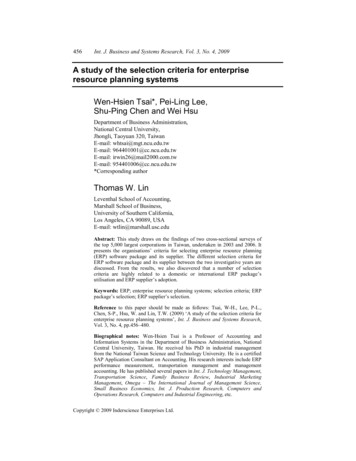


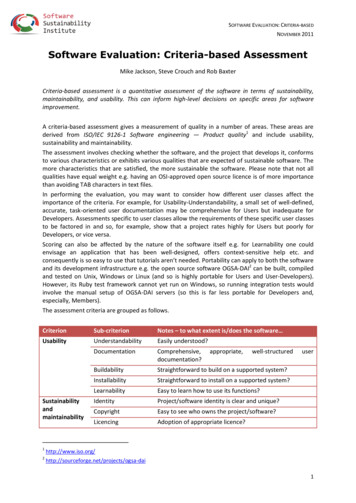
![Trusted Computer System Evaluation Criteria ['Orange Book']](/img/12/dod85.jpg)

